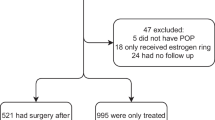Abstract
Introduction and hypothesis
The feasibility of use and long-term outcomes of vaginal pessaries for the management of pelvic organ prolapse (POP) in older women remains unknown. Our aim was to determine successful fit rates and outcomes among older women seeking care for POP.
Methods
This was a retrospective cohort study of 304 consecutive women aged 65 years and older with symptomatic POP undergoing a pessary trial at the outpatient urogynecology clinic in Québec, Canada. Women successfully fitted with a pessary were followed, and survival curves were used to ascertain the median time to pessary discontinuation for women aged 65 to 74 years in comparison with women aged 75 years and older. Long-term use was defined as longer than 1 year. Predictors of a successful fitting and long-term discontinuation were ascertained using logistic and Cox regression analyses.
Results
Half of the women attempting a pessary trial were aged 75 years and older, and 63 % were fitted successfully regardless of age. Women with a history of hysterectomy or reconstructive pelvic surgery, or those with posterior vaginal wall prolapse were more likely to fail initial insertion. For women aged 65 to 74 years and women aged 75 years and older, the cumulative probabilities of continued pessary use were 87.5 % and 80.8 % at 1 year, 80.6 % and 70.9 % at 2 years, and 62.1 % versus 37.8 % at 5 years. Erosions occurred in 19.3 % of long-term users, with women aged 75 years and older more likely to experience vaginal erosions (HR 3.2, 95 % CI 1.6 – 6.3) and discontinue pessary use.
Conclusion
Pessary use is a feasible and acceptable treatment option for the long-term management of symptomatic prolapse in over 60 % of all women aged 65 years and older.


Similar content being viewed by others

References
Kapoor DS, Thakar R, Sultan AH, Oliver R (2009) Conservative versus surgical management of prolapse: what dictates patient choice? Int Urogynecol J 20(10):1157–1161
Diez-Itza I, Aizpitarte I, Becerro A (2007) Risk factors for the recurrence of pelvic organ prolapse after vaginal surgery: a review at 5 years after surgery. Int Urogynecol J Pelvic Floor Dysfunct 18(11):1317–1324
Long CY, Lo TS, Wang CL, Wu CH, Liu CM, Su JH (2012) Risk factors of surgical failure following transvaginal mesh repair for the treatment of pelvic organ prolapse. Eur J Obstet Gynecol Reprod Biol 161(2):224–227
Bai SW, Yoon BS, Kwon JY, Shin JS, Kim SK, Park KH (2005) Survey of the characteristics and satisfaction degree of patients using a pessary. Int Urogynecol J Pelvic Floor Dysfunct 16(3):182–186
Bugge C, Adams EJ, Gopinath D, Reid F (2013) Pessaries (mechanical devices) for pelvic organ prolapse in women. Cochrane Database Syst Rev 2:CD004010
Atnip SD (2009) Pessary use and management for pelvic organ prolapse. Obstet Gynecol Clin Norh Am 36(3):541–563
Trowbridge ER, Fenner DE (2007) Practicalities and pitfalls of pessaries in older women. Clin Obstet Gynecol 50(3):709–719
Bash KL (2000) Review of vaginal pessaries. Obstet Gynecol Surv 55(7):455–460
Arias BE, Ridgeway B, Barber MD (2008) Complications of neglected vaginal pessaries: case presentation and literature review. Int Urogynecol J 19(8):1173–1178
Jones KA, Harmanli O (2010) Pessary use in pelvic organ prolapse and urinary incontinence. Rev Obstet Gynecol 3(1):3–9
Tenfelde S, Tell D, Thomas TN, Kenton K (2015) Quality of life in women who use pessaries for longer than 12 months. Female Pelvic Med Reconstr Surg 21(3):146–149
Hanson LA, Schulz JA, Flood CG, Cooley B, Tam F (2006) Vaginal pessaries in managing women with pelvic organ prolapse and urinary incontinence: patient characteristics and factors contributing to success. Int Urogynecol J Pelvic Floor Dysfunct 17(2):155–159
Yamada T, Matsubara S (2001) Rectocoele, but not cystocoele, may predict unsuccessful pessary fitting. J Obstet Gynaecol 31(5):441–442
Mutone MF, Terry C, Hale DS, Benson JT (2005) Factors which influence the short-term success of pessary management of pelvic organ prolapse. Am J Obstet Gynecol 193(1):89–94
Lone F, Thakar R, Sultan AH, Karamalis G (2011) A 5-year prospective study of vaginal pessary use for pelvic organ prolapse. Int J Gynaecol Obstet 114(1):56–59
Markle D, Skoczylas L, Goldsmith C, Noblett K (2001) Patient characteristics associated with a successful pessary fitting. Female Pelvic Med Reconstr Surg 17(5):249–252
Fernando RJ, Thakar R, Sultan AH, Shah SM, Jones PW (2006) Effect of vaginal pessaries on symptoms associated with pelvic organ prolapse. Obstet Gynecol 108(1):93–99
Wu V, Farrell SA, Baskett TF, Flowerdew G (1997) A simplified protocol for pessary management. Obstet Gynecol 90(6):990–994
Clemons JL, Aguilar VC, Sokol ER, Jackson ND, Myers DL (2004) Patient characteristics that are associated with continued pessary use versus surgery after 1 year. Am J Obstet Gynecol 191(1):159–164
Gorti M, Hudelist G, Simons A (2009) Evaluation of vaginal pessary management: a UK-based survey. J Obstet Gynecol 29(2):129–131
Handa VL, Jones M (2002) Do pessaries prevent the progression of pelvic organ prolapse? Int Urogynecol J Pelvic Floor Dysfunct 13(6):349–351
Author information
Authors and Affiliations
Corresponding author
Ethics declarations
Funding
This study was conducted without external funding support.
Conflicts of interest
None.
Rights and permissions
About this article
Cite this article
Ramsay, S., Tu, L.M. & Tannenbaum, C. Natural history of pessary use in women aged 65 – 74 versus 75 years and older with pelvic organ prolapse: a 12-year study. Int Urogynecol J 27, 1201–1207 (2016). https://doi.org/10.1007/s00192-016-2970-3
Received:
Accepted:
Published:
Issue Date:
DOI: https://doi.org/10.1007/s00192-016-2970-3



